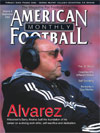AMERICAN FOOTBALL MONTHLY THE #1 RESOURCE FOR FOOTBALL COACHES
Article CategoriesAFM Magazine
|
A Rare BreedA look at how some coaches are taking a different approach in preparing their teams.by: Steve Silverman © More from this issue For a head coach of a professional or college team the bottom line is always the same Ė itís all about winning. But itís the road traveled that makes the man. A coach needs to put a game plan together, teach his players how to perform and find a way to inspire them. It is the motivational aspect of the job that often gives a coach his opportunity to show his individuality. Take Mike Tice, the first-year head coach of the Minnesota Vikings. The Vikings endured a miserable 2001 season, one that started coming apart at the seams at the conclusion of the previous season when they were blown out by the Giants in the NFC Championship game. Tragedy visited the team a....The full article can only be seen by subscribers. Subscribe today!
|
|
|||||||
| HOME |
MAGAZINE |
SUBSCRIBE | ONLINE COLUMNISTS | COACHING VIDEOS |
Copyright 2025, AmericanFootballMonthly.com
All Rights Reserved





